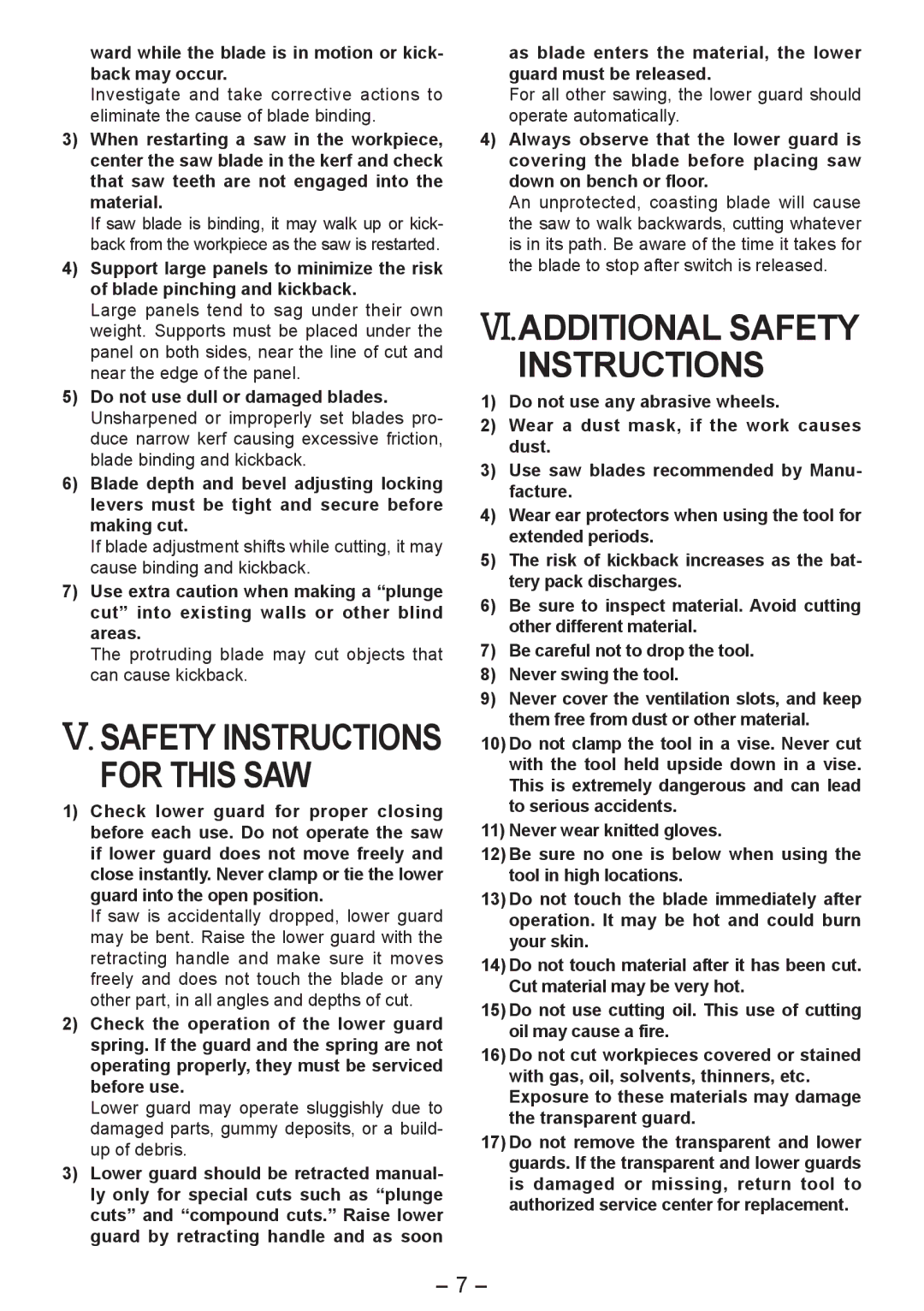ward while the blade is in motion or kick- back may occur.
Investigate and take corrective actions to eliminate the cause of blade binding.
3)When restarting a saw in the workpiece, center the saw blade in the kerf and check that saw teeth are not engaged into the material.
If saw blade is binding, it may walk up or kick- back from the workpiece as the saw is restarted.
4)Support large panels to minimize the risk of blade pinching and kickback.
Large panels tend to sag under their own weight. Supports must be placed under the panel on both sides, near the line of cut and near the edge of the panel.
5)Do not use dull or damaged blades. Unsharpened or improperly set blades pro- duce narrow kerf causing excessive friction, blade binding and kickback.
6)Blade depth and bevel adjusting locking levers must be tight and secure before making cut.
If blade adjustment shifts while cutting, it may cause binding and kickback.
7)Use extra caution when making a “plunge cut” into existing walls or other blind areas.
The protruding blade may cut objects that can cause kickback.
V. SAFETY INSTRUCTIONS
FOR THIS SAW
1)Check lower guard for proper closing before each use. Do not operate the saw if lower guard does not move freely and close instantly. Never clamp or tie the lower guard into the open position.
If saw is accidentally dropped, lower guard may be bent. Raise the lower guard with the retracting handle and make sure it moves freely and does not touch the blade or any other part, in all angles and depths of cut.
2)Check the operation of the lower guard spring. If the guard and the spring are not operating properly, they must be serviced before use.
Lower guard may operate sluggishly due to damaged parts, gummy deposits, or a build- up of debris.
3)Lower guard should be retracted manual- ly only for special cuts such as “plunge cuts” and “compound cuts.” Raise lower guard by retracting handle and as soon
as blade enters the material, the lower guard must be released.
For all other sawing, the lower guard should operate automatically.
4)Always observe that the lower guard is covering the blade before placing saw down on bench or floor.
An unprotected, coasting blade will cause the saw to walk backwards, cutting whatever is in its path. Be aware of the time it takes for the blade to stop after switch is released.
VI.ADDITIONAL SAFETY
INSTRUCTIONS
1)Do not use any abrasive wheels.
2)Wear a dust mask, if the work causes dust.
3)Use saw blades recommended by Manu- facture.
4)Wear ear protectors when using the tool for extended periods.
5)The risk of kickback increases as the bat- tery pack discharges.
6)Be sure to inspect material. Avoid cutting other different material.
7)Be careful not to drop the tool.
8)Never swing the tool.
9)Never cover the ventilation slots, and keep them free from dust or other material.
10)Do not clamp the tool in a vise. Never cut with the tool held upside down in a vise. This is extremely dangerous and can lead to serious accidents.
11)Never wear knitted gloves.
12)Be sure no one is below when using the tool in high locations.
13)Do not touch the blade immediately after operation. It may be hot and could burn your skin.
14)Do not touch material after it has been cut. Cut material may be very hot.
15)Do not use cutting oil. This use of cutting oil may cause a fire.
16)Do not cut workpieces covered or stained with gas, oil, solvents, thinners, etc. Exposure to these materials may damage the transparent guard.
17)Do not remove the transparent and lower guards. If the transparent and lower guards is damaged or missing, return tool to authorized service center for replacement.
- -
